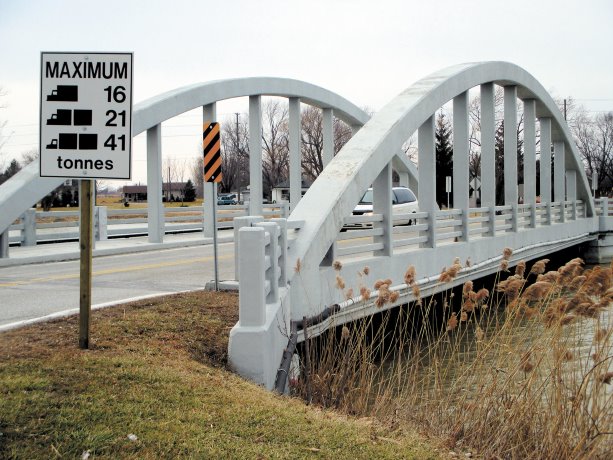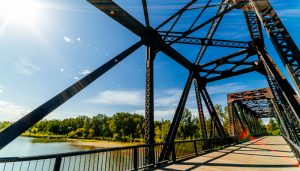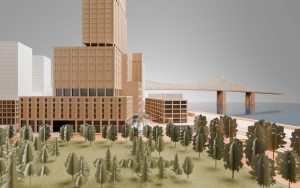The venerable River Canard Bridge is a southwestern Ontario landmark and one of a few of its kind that still line the province’s rural highways and byways dating from the early part of last century.
They’re called, for obvious reasons, Bowstring bridges. The bridge deck is suspended from overhead dual arches with vertical members or "hangers" tying each arch down. They’re also known as Concrete Rainbow Through Arch bridges.
"It’s a unique class of bridge," says Peter Bziuk, Essex County’s manager of design and construction. "There aren’t many of them left."
In the case of the River Canard Bridge, it’s also a huge local tourist attraction, an icon of history in a French settlement that frames St. Joseph Roman Catholic Church.
While a convenient commuter connection for motorists to zip through, for decades artists have gathered on the river banks to paint the bridge and church as one scene.
Now the bridge is undergoing major renovations to keep it viable for decades to come.
Built in 1937 the bridge’s structural length is 36.3 metres and it measures 10.9 metres from the northeast arch’s exterior to the southwest side’s cantilevered sidewalk, outside the arch.
Bziuk said it was also built slightly differently from other Bowstring bridges, which don’t have as many thin and elegant hangers, and is similar to a smaller matching bridge about a kilometre away on Concession Rd. 2, both in the municipality of Amherstburg.
Typically, Bowstring bridges have both thicker arches and hangers, and are characterized by balustrade railings. But here the hangers are very light and the railings are of concrete fence design.
"It’s beautiful," Bziuk said. "You just don’t find many bridges with that arch."
The estimated $430,000 project, with engineering by Stantec Consulting Ltd. (a contractor has yet to be chosen), will be carried out in the summer.
The main issue is keeping the structure adequately load bearing. The bridge currently has weight restrictions due to being designed for 1930s loads, not today’s.
"Over the decades the size of the vehicles have changed, wheel loads have changed," Bziuk said.
But the work must be done in a way that keeps the icon iconic.
The main focus will be on the 22 hangers, 11 on each side. The plan is to strengthen them without distorting the visual look.
"Overall we want the look of the bridge to be the same," Bziuk said.
To a careful observer the end result might be slightly thicker hangers, in profile, but nothing to get too worried about.
The central reason for the work is structural deterioration.
The hangers were built with 1930s concrete and steel. The concrete was characterized by round river stone — "not very good for holding on to the concrete," Bziuk said.
As well, the 1930s reinforcing steel was one inch square and there were also half inch smooth rounded steel loops inside.
The deterioration was becoming visual.
"There are a couple of localized areas where you can see rust bleeding through and showing up on the surface," Bziuk said.
"So that tells us that there’s water getting into the structure and obviously you’re getting some deterioration of your steel."
So the hangers, which vary in height from well less than a metre to five metres at the highest, will be widened by 80 millimetres on each side.
"Now when we put in steel everything is round and has a deformed bar, it has the ability to grip on to the concrete mix (including sharp aggregate), and everything acts as a very integral piece of structural element," Bziuk said.
Four deformed bars per hanger will be added and a welded wire fabric mesh will be wrapped around each expanded hanger’s edges.
But none of the old concrete steel mix will be removed, leaving the bridge in its classic form, a hybrid of old and new.












Recent Comments
comments for this post are closed